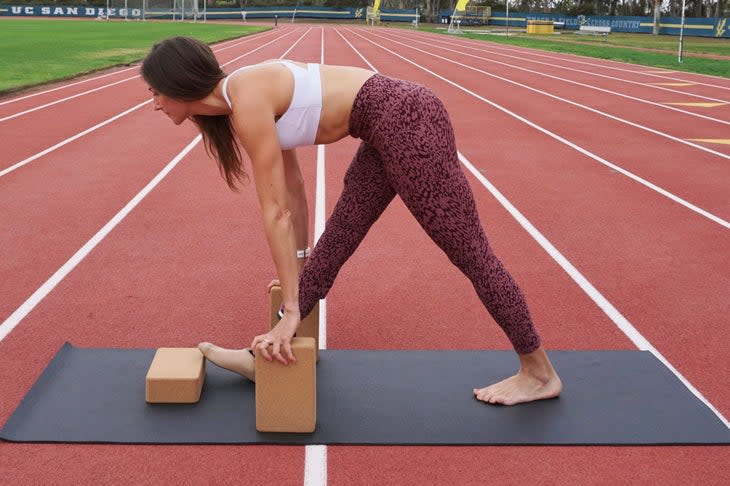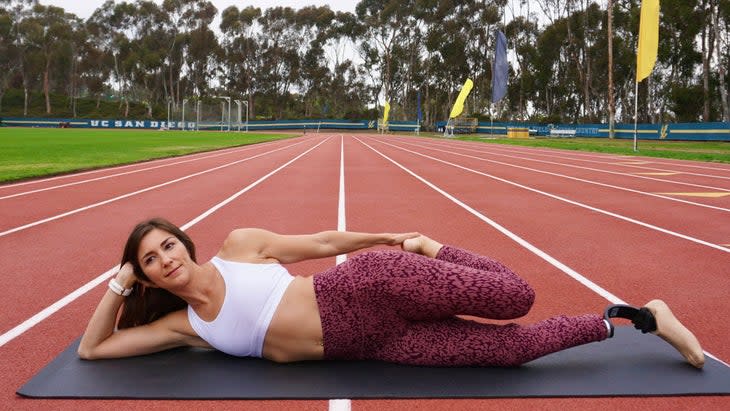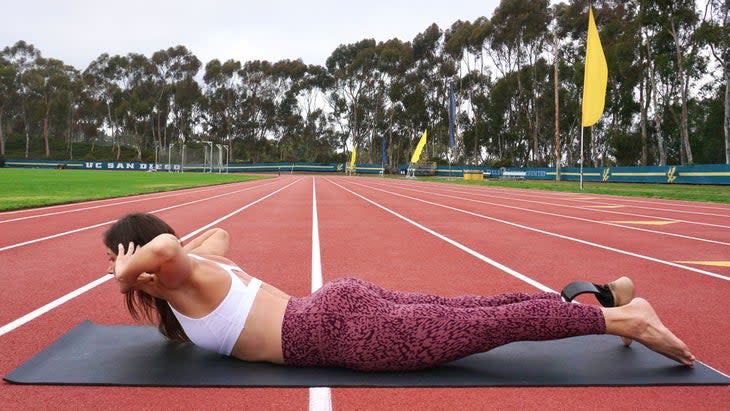8 Best Yoga Stretches for Runners
This article originally appeared on Yoga Journal
On June 1, Global Running Day, we celebrate runners around the world--and their hardworking muscles. As much as runners love to run, this demanding sport is hard on the body. Tight muscles put even more strain on tired joints. But yoga's targeted dynamic stretching can help. In fact, a 2006 study on the effects of yoga stretches for runners showed significant improvements in running performance compared to runners who didn't practice yoga. Additionally, the mindful nature of yoga emphasizes body-awareness, which can lower the potential for injuries or strains.
Why yoga stretches are essential for runners
Most of the injuries that runners experience are due to overuse of muscles from the repetitive nature of the sport, says Kelly Bruno M.D., an ultra-marathon runner, pain-management physician, and clinical instructor at the University of California, San Diego. This phenomenon is called functional shortening, and it decreases muscle flexibility, leaving the muscles prone to injury.
In runners, this kind of muscle shortening can lead to tight hamstrings and hip flexors, leaving the knees and hips at risk of pain and injury. Relying on yoga stretches that are targeted for runners can stretch these muscles, assist in preventing injury, and keep you on the track, trail, or road to bank more miles.
8 yoga stretches for runners
The following series of yoga poses can serve as a go-to sequence for every runner. The series of yoga stretches is accessible for all levels of runners, targets the most-used running muscles, and takes less than 10 minutes. By incorporating these yoga stretches before and after every run, you'll keep your hardworking body balanced and healthy.

High Lunge with goal post arms
In a natural running stance, the elbows are bent by your side at 90 degrees as you swing your arms forward and back. This causes the shoulders and upper back to round forward, causing tightness in the chest muscles and decreased mobility in the upper back. This pose addresses tense chest muscles as well as tight hip flexors.
Instructions: Start in Adho Mukha Svanasana (Downward-Facing Dog Pose). Step your right foot between your hands and raise your torso up, placing your hands on your hips. Keep your back knee off the ground, or lower it to the mat if your legs are tired. Raise your arms up and bend your elbows to the height of your shoulders, making a goal-post shape with your arms. Press your elbows back slightly to feel a stretch across your chest and fronts of your shoulders. Hold for 2-3 breath cycles.

Parsvottanasana (Pyramid Pose) with Blocks
The calves and ankles are some of the most under-addressed parts of the body when it comes to stretching. "Tight calves can cause strain on the ankle joint, resulting in injuries like shin splints and plantar fasciitis," explains Dr. Bruno. Indeed, the calves are responsible for pushing off every time you take another step and reducing the impact as you land. Show those calves and ankle joints some love with this juicy stretch with blocks. Bonus, it also lengthens the hamstrings!
Instructions (you'll need three yoga blocks or stacks of books): From Crescent Lunge, shorten your stance so the outer heel of your back foot can ground down. Place a block under the ball of your front right foot, so you balance on your right heel. Then place the other two blocks on both sides of your front foot. Inhale to extend the back and open your chest. Exhale to come forward and put your hands on the blocks. Try to maintain a softness in the front knee so you don't overextend it. The deeper your forward fold, the deeper the stretch in your front calf muscle. Hold here for 2-3 breath cycles.

Prasarita Padottanasana (Wide-legged Standing Forward Bend) with Fingers Interlaced
Nothing beats a good stretch for the inner thighs (adductors). These muscles are constantly working while running; they decelerate your front leg as your foot strikes down and stabilize the pelvis as your back leg swings forward to take the next step. It's no wonder runners tend to have tight adductors; they are multitaskers during each phase of the running cycle. This yoga stretch helps to lengthen the adductors and maintain balance in the pelvis for runners.
Instructions: From Pyramid Pose, turn toward the long edge of your mat and make your feet parallel. Clasp your hands behind your back, straighten your elbows and reach down toward your tailbone. On an exhale, fold forward, bringing your head between your legs. Allow the hands to lift off of your back and reach up and over your head for an added chest stretch. Hold for 3-5 breath cycles.

Anantasana (Reclining Pose Dedicated to Vishnu) variation
"My quadriceps are so flexible," said no runner, ever. The quads are a group of four muscles that extend your knee and lengthen your stride as you propel forward while running. When the flexibility pf the quads is hampered, it leaves the hamstrings and knees prone to injury. This pose stretches the quads in an offloaded position, so you don't have to balance on your other leg at the same time.
Instructions: Come to the ground and lie on your right side, stacking your left hip over your right. You can extend your right are long and rest your head on your bicep, or bend you elbow and prop your head up in your hand. Bend your left knee and catch hold of it with your left hand if possible. If it is not possible, loop a yoga strap around your left foot and with the strap in your left hand, draw the foot toward your buttocks. Keep your left knee aligned over your right. (Don't let the left knee escape behind the body). Hold for 3-5 breaths.

Salabhasana (Locust Pose) variation
Locust is another chest expanding pose which also focuses on strengthening the back muscles. In this variation, keep your feet on the ground, allowing the gluteus muscles to remain relatively relaxed. Keep your awareness on strengthening the back and opening your chest.
Instructions: From Reclining Pose Dedicated to Vishnu Variation, roll onto your belly, forehead to the ground. Gently touch your fingertips to the back of your head. Without placing any weight on the hands, inhale and raise the chest, head, and elbows away from the mat. Anchor your pelvis and feet to the ground and extend your back while drawing your shoulder blades toward each other to focus on increasing your upper back strength. Hold here for 2-3 breath cycles.

Gracious Pose
The tibialis anterior muscle, which extends along the front of the shin, helps lift your foot and dorsiflex your ankle during the swing phase of running. It also absorbs some of the impact force when your foot strikes the ground. Tight tibialis anterior muscles inhibit plantarflexion (pointing the toes), making it difficult to effectively push off the ground when you're walking or running. Stretching the tibialis anterior muscle may also help to prevent shin splints, which is a common overuse injury in runners.
Instructions: From Salabhasana (Locust Pose), press yourself into a kneeling position, sitting back on your heels, with the top of the feet and ankles contacting the mat. Place a block under your buttocks to prop yourself up high enough so you do not feel strain in your hips, knees or the front of your ankles. As you regularly practice this pose, slowly decrease the height of the block so you can further lengthen the tibialis anterior muscles. Hold for 3-5 breath cycles or longer.

Supta Eka Pada Rajakapotasana (Reclining Pigeon Pose)
The gluteal muscles are strong hip extensors. They turn on after you strike the ground, giving you the power to propel forward as you run. They also help to absorb the shock on heel strike. Needless to say, these muscles tighten and fatigue easily due to the repetitive nature of the running gait. This offloading pose allows your body to relax while taking strain off of your knees so you can focus on the hip and glute stretch.
Instructions: Roll onto your back from Locust Pose. Bring your knees to your chest, and cross the right ankle above the left knee, creating a figure-four shape. Press your right knee away from your chest, keeping your right foot dorsiflexed. Hold here for 3-5 breath cycles or longer.

Reclining IT Band Stretch
Runners have notoriously tight iliotibial bands (IT bands), which can lead to imbalances and induce knee or hip injury. The IT band is the strong, stabilizing bundle of fascia on the outer sides of the thighs). If it's tight, it can cause IT band syndrome, which translates into hip and knee pain. This pose stretches the glutes, outer hips and IT bands, and also lengthens the low back.
Instructions: From Reclining Pigeon Pose, keep the right ankle above the left knee, and let the left hip rotate out to the side until your right foot meets the ground. If it doesn't make it all the way there, put a block under the right foot. You can even turn your head to the right to add a slight element of a twist, but the idea is not to twist the spine but to stretch that outer right hip. So, keep your sacrum and lower back relaxed on the floor. Hold for 3-5 breath cycles.
After practicing this sequence on the right side, reset in Downward-facing Dog Pose and practice on the left side, holding for the same amount of breaths.
Practice this sequence along with Kelly Bruno
https://www.instagram.com/reel/CeFBgKOggey/
For exclusive access to all of our fitness, gear, adventure, and travel stories, plus discounts on trips, events, and gear, sign up for Outside+ today.

